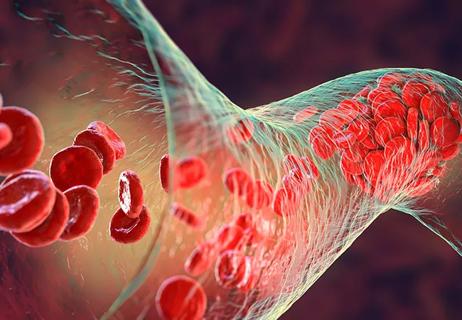Evidence, clinical considerations, and why more research is still needed

Mounting evidence has linked SARS-CoV-2 infection in children with a higher risk of developing Type 1 (T1D) and Type 2 (T2D) diabetes. While researchers continue to understand associations between COVID-19 and diabetes in pediatric patients, Roy Kim, MD, a pediatric endocrinologist, cautions against an overly deterministic view of diabetic risk associated with these viral exposures. Instead, he urges a patient-specific approach with awareness of clinically suspicious symptoms and reinforces pediatrician-recommended vaccinations.
Cleveland Clinic is a non-profit academic medical center. Advertising on our site helps support our mission. We do not endorse non-Cleveland Clinic products or services. Policy
In January 2022, the Centers for Disease Control and Prevention published a report suggesting that pediatric patients younger than 18 had a higher rate of developing diabetes following a COVID-19 infection than those without COVID-19. However, T1D and T2D were not separated.1
Several months later, a study published in JAMA Network Open examined the onset of T1D, specifically in pediatric patients who had COVID-19, and found that a T1D diagnosis was more likely to occur in this cohort at months one, three, and six after infection than in those with a non-COVID-19 respiratory infection.2
In a matched cohort of 571,256 pediatric patients from March 2020 to December 2021—285,628 with COVID-19 and 285,628 with non-COVID-19 respiratory infections—investigators found that within six months of a COVID-19 diagnosis, 123 patients (0.043%) had received a new diagnosis of T1D. In addition, their analysis showed that 72 (0.025%) were diagnosed with T1D within six months after a non–COVID-19 respiratory infection.
The authors note several limitations, including the study’s retrospective and observational design, the potential for misclassification of diabetes type, and other factors for which they did not account. While the study raises concerns for longer-term autoimmune manifestations related to COVID-19, Dr. Kim notes that more research is still needed.
“There have been many studies linking viral infections with later emergence of type 1 diabetes,” he says. “In general, viral infections are regarded as accelerants—rather than causes—for the emergence of disease. The risk is established in utero by genetics and early life exposures before the respiratory virus exposure. While we can’t rule out causation, the history of research exploring the connection between antecedent viral infections and T1D seems to suggest they are neither necessary nor sufficient by themselves to cause the disease.”
He says, “We should also keep in mind that many or even most children will become infected with the same viruses and only a small number will develop type 1 diabetes.”
Researchers have also looked at associations between COVID-19 and T2D in younger patients. Findings from a study published in the Journal of Pediatrics show that the disease burden increased significantly during the coronavirus pandemic.3 Researchers assessed electronic health records from 3,113 young patients across 24 different U.S. centers from March 2018 to March 2021 and determined a 77.2% increase in T2D from the start of the pandemic in 2020.
The authors note that the rise is likely multifactorial, owing to several possible causes, including increases in body mass index (BMI), possible changes in the home environment, and psychological stress.
A study led by researchers at Cleveland Clinic suggests that higher rates of T2D in adult patients who had COVID-19 may be the result of increased engagement with a healthcare system and not a sudden spike in blood sugar levels mediated by the virus, which had been speculated.
Cleveland Clinic researchers analyzed blood sugar rates over time in patients who tested positive for COVID-19 and those who tested negative to address questions about how the virus affects the pancreas and blood sugar regulation.
“The results suggest the COVID-positive patients could have been less likely to receive a type 2 diabetes diagnosis if they had tested negative, just due to the extra clinical attention they receive during COVID management,” says Daniel Rotroff, PhD, of Cleveland Clinic’s Department of Quantitative Health Sciences. The findings appear in Diabetes.4
While several reports suggest an association between T1D and T2D with a history of SARS-CoV-2, Dr. Kim says he has not seen a noticeable increase in his practice. However, he acknowledges that small changes in risk may not be detectable at one center or even in one city or region.
“For pediatric patients with well-controlled T1D, there does not appear to be a higher risk to acquire COVID-19 or present with more severe manifestations, but patients and families should remain conservative regarding preventive care.”
He continues, “There does, however, seem to be a link with more severe COVID-19 disease in children with obesity, and obesity is a major risk factor for T2D in adolescents.” He says the common denominator of obesity may mediate this link.
As researchers continue to generate more data on associations between COVID-19 in children and the onset of diabetes, Dr. Kim reinforces the importance of appropriate screening practices.
“The National Heart Lung and Blood Institute recommends screening for type 2 diabetes in children age 10 years and older who have T2D Mellitus risk factors, which include:
“There is no routine screening for type 1 diabetes that is recommended; however, suggestive symptoms could include increased thirst and urination, weight loss, and later symptoms could include nausea, vomiting, rapid breathing, and severe loss of energy,” he says.
“It’s also important that pediatric providers encourage patients and their families to adhere to their recommended immunization schedule and follow public health guidelines as required,” concludes Dr. Kim.
References

A review of IDSA and NIH guidelines

Results from the large, single-center, retrospective study have multiple implications for preventive care

Will enable patients with long COVID to enroll in national clinical trials

Team collaborates to explore effects of genetic mutations to proteins OAS and RNase L

As the pandemic evolves, rheumatologists must continue to be mindful of most vulnerable patients

Early results suggest positive outcomes from COVID-19 PrEP treatment

Elevated levels of vWF and FVIII associated with risk of blood clots, severe COVID-19 and death

Through collaboration, the Center for Quantitative Metabolic Research will help improve Cleveland Clinic’s standing as a leader for Type 2 diabetes and obesity research